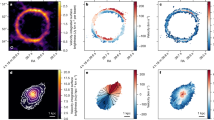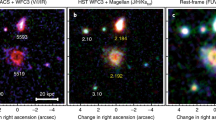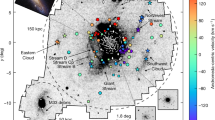Abstract
Although grand-design spiral galaxies are relatively common in the local Universe, only one has been spectroscopically confirmed1 to lie at redshift z > 2 (HDFX 28; z = 2.011); and it may prove to be a major merger that simply resembles a spiral in projection. The rarity of spirals has been explained as a result of disks being dynamically ‘hot’ at z > 2 (refs 2–5), which may instead favour the formation of commonly observed clumpy structures6,7,8,9,10. Alternatively, current instrumentation may simply not be sensitive enough to detect spiral structures comparable to those in the modern Universe11. At z < 2, the velocity dispersion of disks decreases12, and spiral galaxies are more numerous by z ≈ 1 (refs 7, 13–15). Here we report observations of the grand-design spiral galaxy Q2343-BX442 at z = 2.18. Spectroscopy of ionized gas shows that the disk is dynamically hot, implying an uncertain origin for the spiral structure. The kinematics of the galaxy are consistent with a thick disk undergoing a minor merger, which can drive the formation of short-lived spiral structure16,17,18. A duty cycle of <100 Myr for such tidally induced spiral structure in a hot massive disk is consistent with its rarity.
This is a preview of subscription content, access via your institution
Access options
Subscribe to this journal
Receive 51 print issues and online access
$199.00 per year
only $3.90 per issue
Buy this article
- Purchase on Springer Link
- Instant access to full article PDF
Prices may be subject to local taxes which are calculated during checkout


Similar content being viewed by others
References
Dawson, S. et al. Optical and near-infrared spectroscopy of a high-redshift hard X-ray-emitting spiral galaxy. Astron. J. 125, 1236–1246 (2003)
Genzel, R. et al. The rapid formation of a large rotating disk galaxy three billion years after the Big Bang. Nature 442, 786–789 (2006)
Law, D. R. et al. Integral field spectroscopy of high-redshift star-forming galaxies with laser-guided adaptive optics: evidence for dispersion-dominated kinematics. Astrophys. J. 669, 929–946 (2007)
Förster Schreiber, N. M. et al. The SINS survey: SINFONI integral field spectroscopy of z ∼ 2 star-forming galaxies. Astrophys. J. 706, 1364–1428 (2009)
Law, D. R. et al. The kiloparsec-scale kinematics of high-redshift star-forming galaxies. Astrophys. J. 697, 2057–2082 (2009)
Conselice, C. J., Blackburne, J. A. & Papovich, C. The luminosity, stellar mass, and number density evolution of field galaxies of known morphology from z = 0.5 to 3. Astrophys. J. 620, 564–583 (2005)
Elmegreen, D. M., Elmegreen, B. G., Rubin, D. S. & Schaffer, M. A. Galaxy morphologies in the Hubble Ultra Deep Field: dominance of linear structures at the detection limit. Astrophys. J. 631, 85–100 (2005)
Law, D. R. et al. The physical nature of rest-UV galaxy morphology during the peak epoch of galaxy formation. Astrophys. J. 656, 1–26 (2007)
Bournaud, F. & Elmegreen, B. G. Unstable disks at high redshift: evidence for smooth accretion in galaxy formation. Astrophys. J. 694, L158–L161 (2009)
Law, D. R. et al. An HST/WFC3-IR morphological survey of galaxies at z = 1.5 - 3.6: I. Survey description and morphological properties of star forming galaxies. Astrophys. J. 745, 85–122 (2012)
Conselice, C. J. et al. The tumultuous formation of the Hubble sequence at z > 1 examined with HST/Wide-Field Camera-3 observations of the Hubble Ultra Deep Field. Mon. Not. R. Astron. Soc. 417, 2770–2788 (2011)
Wright, S. A. et al. Dynamics of galactic disks and mergers at z ∼ 1.6: spatially resolved spectroscopy with Keck Laser Guide Star Adaptive Optics. Astrophys. J. 699, 421–440 (2009)
Abraham, R. G. & van den Bergh, S. The morphological evolution of galaxies. Science 293, 1273–1278 (2001)
Labbé, I. et al. Large disklike galaxies at high redshift. Astrophys. J. 591, L95–L98 (2003)
Elmegreen, B. G., Elmegreen, D. M., Fernandez, M. X. & Lemonias, J. J. Bulge and clump evolution in Hubble Ultra Deep Field clump clusters, chains and spiral galaxies. Astrophys. J. 692, 12–31 (2009)
Bottema, R. Simulations of normal spiral galaxies. Mon. Not. R. Astron. Soc. 344, 358–384 (2003)
Dubinksi, J., Gauthier, J.-R., Widrow, L. & Nickerson, S. Spiral and bar instabilities provoked by dark matter satellites. Astron. Soc. Pacific Conf. Series 396, 321–324 (2008)
Dobbs, C. L., Theis, C., Pringle, J. E. & Bate, M. R. Simulations of the grand design galaxy M51: a case study for analyzing tidally induced spiral structure. Mon. Not. R. Astron. Soc. 403, 625–645 (2010)
Kennicutt, R. C., Jr The global Schmidt law in star-forming galaxies. Astrophys. J. 498, 541–552 (1998)
Bigiel, F. et al. The star formation law in nearby galaxies on sub-kpc scales. Astron. J. 136, 2846–2871 (2008)
Genzel, R. et al. The SINS survey of z ∼ 2 galaxy kinematics: properties of the giant star-forming clumps. Astrophys. J. 733, 101–130 (2011)
Elmegreen, B. G. & Elmegreen, D. M. Observations of thick disks in the Hubble Space Telescope Ultra Deep Field. Astrophys. J. 650, 644–660 (2006)
Genzel, R. et al. From rings to bulges: evidence for rapid secular galaxy evolution at z ∼ 2 from integral field spectroscopy in the SINS survey. Astrophys. J. 687, 59–77 (2008)
Toomre, A. in The Structure and Evolution of Normal Galaxies (eds Fall, S. M. & Lynden-Bell, D.) 111 (Cambridge University Press, 1981)
Elmegreen, D. M., Elmegreen, B. G., Ravindranath, S. & Coe, D. A. Resolved galaxies in the Hubble Ultra Deep Field: star formation in disks at high redshift. Astrophys. J. 658, 763–777 (2007)
Kriek, M. et al. The Hubble sequence beyond z = 2 for massive galaxies: contrasting large star-forming and compact quiescent galaxies. Astrophys. J. 705, L71–L75 (2009)
Förster Schreiber, N. M. et al. Constraints on the assembly and dynamics of galaxies. I. Detailed rest-frame optical morphologies on kiloparsec scale of z ∼ 2 star-forming galaxies. Astrophys. J. 731, 65–99 (2011)
Purcell, C. W. et al. The Sagittarius impact as an architect of spirality and outer rings in the Milky Way. Nature 477, 301–303 (2011)
Wadsley, J. W., Stadel, J. & Quinn, T. Gasoline: a flexible, parallel implementation of Tree SPH. N. Astron. 9, 137–158 (2004)
Martig, M. & Bournaud, F. Formation of late-type spiral galaxies: gas return from stellar populations regulates disk destruction and bulge growth. Astrophys. J. 714, L275–L279 (2010)
Acknowledgements
D.R.L and C.C.S have been supported by grant GO-11694 from the Space Telescope Science Institute, which is operated by the Association of Universities for Research in Astronomy, Inc., for NASA, under contract NAS 5-26555. A.E.S acknowledges support from the David and Lucile Packard Foundation. C.R.C acknowledges support from the US National Science Foundation through grant AST-1009452. D.R.L appreciates discussions with J. Taylor, R. Abraham, J. Dubinski, F. Governato and A. Brooks, and thanks M. Peeples for help in obtaining the Keck/OSIRIS data.
Author information
Authors and Affiliations
Contributions
D.R.L. performed the morphological analysis of the Hubble Space Telescope data and wrote the main manuscript text. The Keck/OSIRIS data were obtained by D.R.L. and A.E.S., and analysed by D.R.L. with extensive input from A.E.S. and C.C.S.. N.A.R. provided the Keck/LRIS spectra, Spitzer/MIPS photometry and stellar population modelling code, C.R.C. contributed the hydrodynamic galaxy simulations, and D.K.E. provided the Keck/NIRSPEC spectra. All authors reviewed, discussed and commented on the manuscript.
Corresponding author
Ethics declarations
Competing interests
The authors declare no competing financial interests.
Supplementary information
Supplementary Information
This file contains Supplementary Text and Data, Supplementary Figures 1-12, Supplementary Table 1 and additional references. (PDF 1048 kb)
PowerPoint slides
Rights and permissions
About this article
Cite this article
Law, D., Shapley, A., Steidel, C. et al. High velocity dispersion in a rare grand-design spiral galaxy at redshift z = 2.18. Nature 487, 338–340 (2012). https://doi.org/10.1038/nature11256
Received:
Accepted:
Published:
Issue Date:
DOI: https://doi.org/10.1038/nature11256
This article is cited by
-
Dark energy constraints on masses and sizes of large scale cosmic structures
Astrophysics and Space Science (2018)
Comments
By submitting a comment you agree to abide by our Terms and Community Guidelines. If you find something abusive or that does not comply with our terms or guidelines please flag it as inappropriate.



